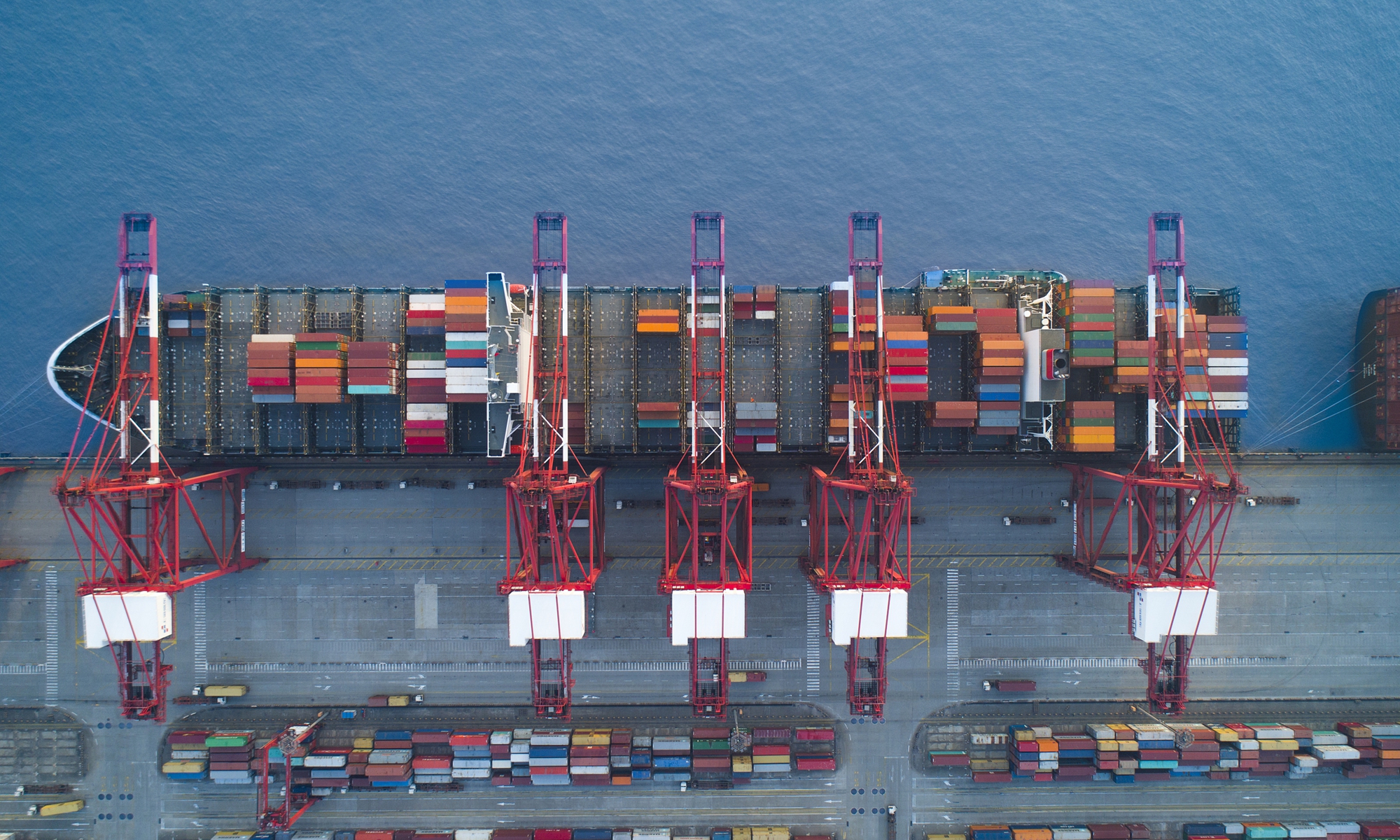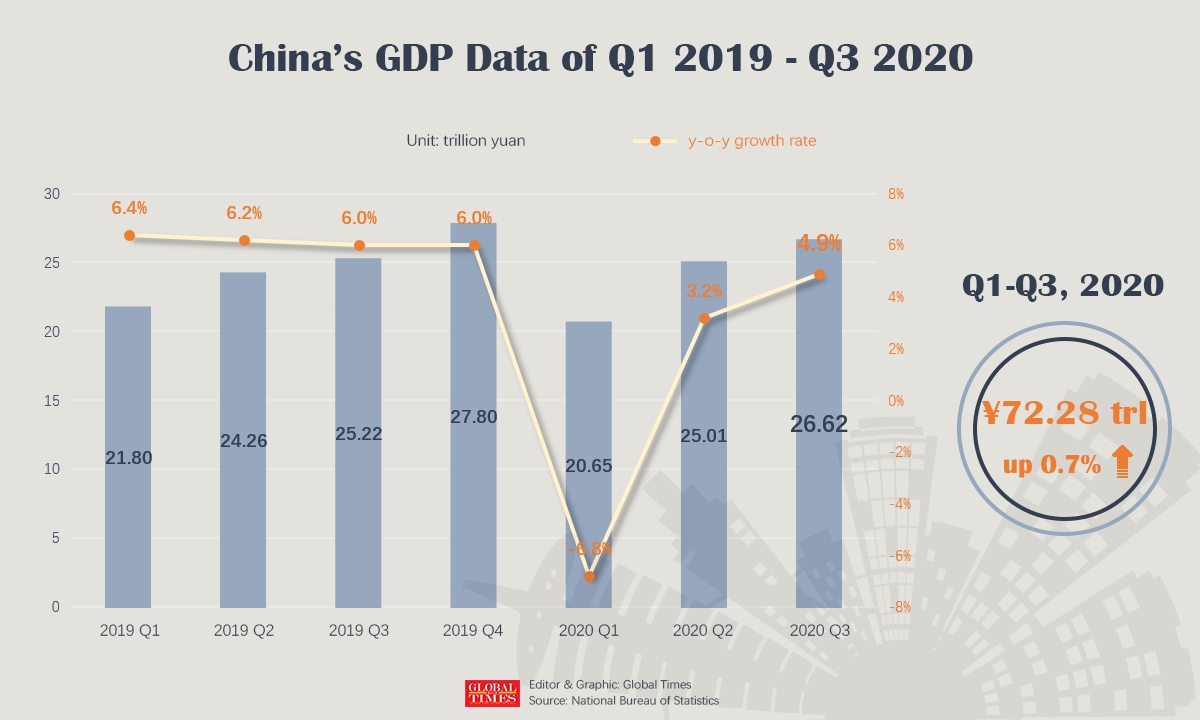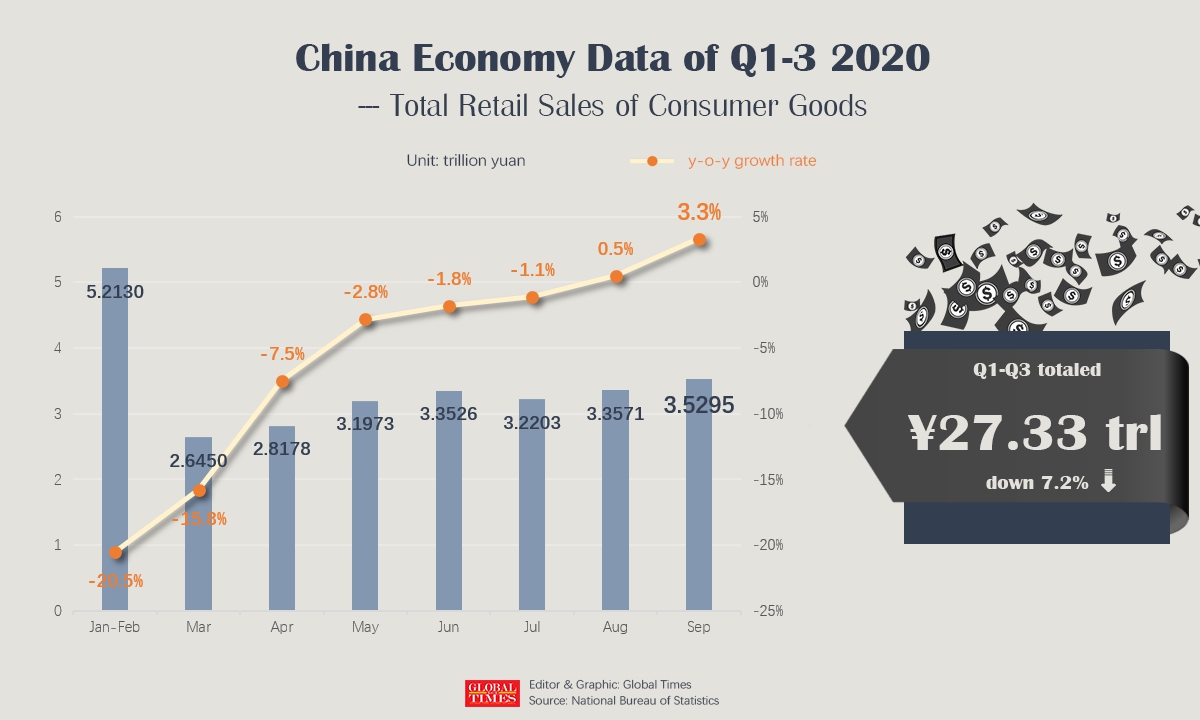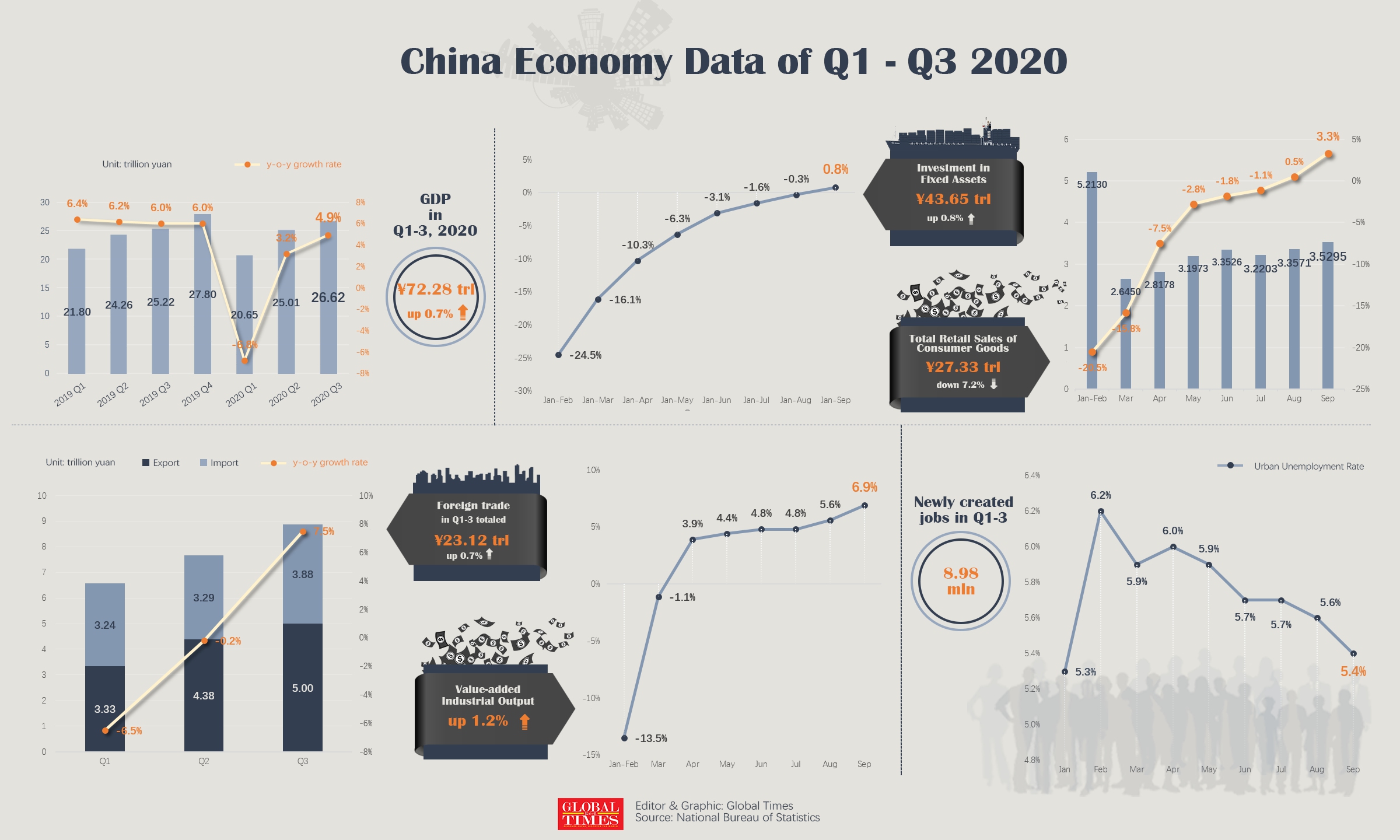Strong Q3 GDP results leave ample policy options to ensure whole-year growth of 2-3% despite COVID-19
By Chu Daye Source: Global Times Published: 2020/10/19 19:42:29

GDP Photo: VCG
The Chinese economy bounced back into positive territory — growing 0.7 percent — in the first three quarters of the year after the country has put COVID-19 epidemic under control, official data showed on Monday, as analysts predicted a further recovery would be sustained in the upcoming fourth quarter to ensure a whole-year GDP growth of 2-3 percent.

China's GDP Data of Q1 2019 - Q3 2020 Infographic: GT
China's GDP in the third quarter expanded 4.9 percent year-on-year, as the country's economic recovery accelerates amid recovering domestic consumption, better-than-expected exports and improving investments.
Although GDP growth from July to September missed initial expectations shown in a Reuters poll, analysts said the third quarter's performance underscored China's strong momentum for recovery in wake of the global pandemic that has so far infected 40 million people worldwide as of Monday. China's status in leading and facilitating the global recovery has been further confirmed upon the release of these economic data, they said.

China Economy Data of Q1-3 2020 --- Total Retail Sales of Consumer Goods Infographic: GT
World-beating recovery
China's GDP in the first three quarters totaled 72.28 trillion yuan ($10.80 trillion), with retail sales in the third quarter bouncing back into positive territory for the first time this year and fixed-asset investment growing for the first time from January to September.
China also completed 99.8 percent of its 2020's target to create 9 million jobs in urban areas, National Bureau of Statistics spokesperson Liu Aihua said.
"A 4.9-percent-reading already shows that China has taken the lead in realizing economic recovery even as the global economy enters a recession due to the pandemic," Cong Yi, a professor at the Tianjin University of Finance and Economics, told the Global Times on Monday, noting that floods in the most recent summer months and declining global investment from political turmoil may have dragged down growth prospects by a notch.

China's National Bureau of Statistics announces on Monday that value-added industrial output, an important economic indicator, expanded 1.2 percent year-on-year in the first three quarters. Photo: cnsphoto
China's industrial output rose by 5.8 percent in the third quarter and exports jumped 10.2 percent year-on-year, according to NBS.
"Pre-epidemic-level readings have already been reached for fixed-asset investments, exports and industrial value-added services, proving that China has successfully shaken off the pandemic's negative impact," Liao Qun, chief economist at China CITIC Bank in Hong Kong, told the Global Times.
"Unlike the second quarter's strong production but weak demand, both channels paved the way for strong growth in the third quarter. In particular, domestic demand has accelerated the revival," Liu Xuezhi, an economist at the Bank of Communications, told the Global Times.
However, due to the methods used to compile GDP data, a slow recovery in consumption has caused the actual GDP reading to be slightly lower than the market's estimation.
A third quarter GDP reading falling short means that China's fourth quarter GDP has to increase by around 6 percent to match the IMF's latest forecast of a 1.9 percent annual growth rate in 2020, according to a Global Times calculation.
Multiple analysts and financial institutions interviewed by the Global Times on Friday predicted GDP could reach 7 percent in the fourth quarter.
However, a 4.9 percent growth rate still puts China in a leading position in terms of the recovery process, while other countries continue to struggle in containing the virus.
According to IMF, the US economy will contract 4.3 percent this year, while Germany will shrink 6.0 percent and India 10.3 percent.
China's share in the global economy will increase to 14.5 percent this year from 2019's 13.6 percent, contributing to a world economy that will contract by 4.4 percent, according to a report by the Chasing Institute.
Headwinds
Despite China's top-of-the-class performance, there are still aspects fueling concerns, analysts pointed out.
Gao Liankui, research program director of China and World Economic Governance at Renmin University of China, said that current consumption remains relatively sluggish due to the lack of powerful stimulus measures, underscoring the degree to which China's economic growth now mainly relies on consumer spending.
The slow recovery in the services sector, which provides the majority of jobs for new college graduates, and rising ratio of household debt to GDP also pose challenges.
In the first three quarters of the year, consumption dragged down GDP growth by 2.5 percentage points, whereas investment and exports contributed 3.1 percent and 0.1 percent, respectively, according to the NBS.
However, NBS' Liu said retail sales in China are clearly emerging from the "deep shock" brought about as a result of the coronavirus.
Consumption rebounded strongly in the third quarter and contributed 1.7 percentage points of GDP growth for the quarter, compared with 2.6 percent and 0.6 percent contributed by investment and exports.
A continued recovery in retail and consumption in China's enormous market is of great benefit to the Chinese economy, which is in the process of building a new economic development pattern of "dual circulation" as well as the recovery of the world economy, Liu said, noting that the country's recovery trend should be sustained in the fourth quarter.

China Economy Data of Q1-3 2020 Infographic: GT
Resilience
Although China is unlikely to see a major domestic resurge of the epidemic again, analysts said that uncertainties in the fourth quarter include another infection peak during the winter season and deteriorating ties between China and the US.
However, a resilience of the Chinese economy can be preserved as the Chinese government saved some of its easing policies on account of better-than-expected economic performance in the second quarter.
"The government could roll out more 'easing policies' to ensure growth and reach the range of around 2 percent for the year," Liao said.
What's more, consumption could be further tapped as a recovering trend is further strengthened in the fourth quarter, paving the way for China to achieve an annual GDP expansion of about 2-3 percent despite a global recession, analysts noted.
There is still much potential, Liao said, noting that despite the fanfare surrounding the return of National Day holiday tourism, tourist revenue is roughly only 70 percent of pre-epidemic levels.
In a sign of further potential for consumption, China's per capita disposable income for the first three quarters reached 23,781 yuan and posted an actual growth of 0.6 percent year-on-year, returning to positive growth for the first time this year in the wake of the coronavirus.
"Looking at 2021, when we could reasonably expect the access of effective vaccines, 'revenge spending' will finally arrive, giving further impetus to the recovery of consumption," Liao said.
A report from the Zhixin Investment Research Institute predicted that China's GDP will grow by 7 percent in the fourth quarter, with a full-year growth of 2.7-3.3 percent.
RELATED ARTICLES:
Posted in: ECONOMY